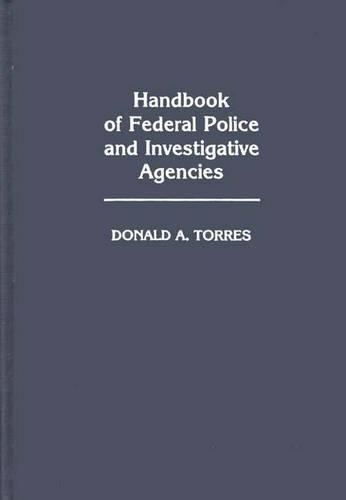
Handbook of Federal Police and Investigative Agencies
(Hardback)
Publishing Details
Handbook of Federal Police and Investigative Agencies
By (Author) Donald A. Torres
Bloomsbury Publishing PLC
Greenwood Press
19th November 1985
United States
Classifications
Tertiary Education
Non Fiction
Police and security services
Regional, state and other local government
363.20973
Physical Properties
Hardback
411
Description
This in-depth survey of the federal law enforcement system is divided into four sections. The first gives an overview of the types of positions available, with their requirements and benefits. The entire second section is devoted to the Department of Justice, the agency solely responsible for the prosecution of federal offenses. . . . (The third section consists of 42 black and white illustrations of federal agency badges.) The agency profiles in the fourth section follow a standard format. . . . The profiles run the gamut of federal enforcement agencies, from the large and well-known, such as the Drug Enforcement Administration and the Immigration and Naturalization Service, to small and obscure agencies such as the Supreme Court Police. The detailed information conveniently brought together in this handbook will make it a useful reference source not only for specialized law enforcement collections but wherever there is interest in public policy or a need for career information. Booklist Here is an in-depth study both of the larger, more publicized federal enforcement agencies and of the smaller ones about which little is known. Special attention is given to agency funding, types of positions available, personnel practices, and to the clarification of criminal, general investigator, and uniformed police positions. The Department of Justice and its specific agencies that perform law enforcement duties are examined in great detail. Photographs of the badges issued by the various federal agencies are included. Profiles of sixty-one federal police and investigative agencies complete with organizational structure charts, personnel strengths, and agency responsibility are arranged alphabetically. Detailed appendices include several examples of the training required for federal agents, important personnel forms, and the 1984 fiscal year salary schedule.
Reviews
This in-depth survey of the federal law enforcement system is divided into four sections. The first gives an overview of the types of positions available, with their requirements and benefits. The entire second section is devoted to the Department of Justice, the agency solely responsible for the prosecution of federal offenses. The functions of its various units are described, with the exception of those such as the FBI that have enforcement responsibilities; these latter are found among the 61 police and investigative agencies covered in the fourth section, which makes up the bulk of this handbook. (The third section consists of 42 black-and-white illustrations of federal agency badges.) The agency profiles in the fourth section follow a standard format. A brief history of the agency is followed by a discussion of its organizational structure, usually accompanied by an organization chart. . . . Illustrative data are provided on funding, personnel strength, and the agnecy's annual work load and accomplishments. Each profile concludes with discussions of the agency's jurisdiction and legislative authority as well as qualifications and training for agency positions. . . . The profiles run the gamut of federal enforcement agencies, from the large and well known, such as the Drug Enforcement Administration and the Immigration and Naturalization Service, to small and obscure agencies such as the Supreme Court Police. The detailed information conveniently brought together in this handbook will make it a useful reference source not only for specialized law enforcement collections but wherever there is interest in public policy or a need for career information.-Reference Books Bulletin
"This in-depth survey of the federal law enforcement system is divided into four sections. The first gives an overview of the types of positions available, with their requirements and benefits. The entire second section is devoted to the Department of Justice, the agency solely responsible for the prosecution of federal offenses. The functions of its various units are described, with the exception of those such as the FBI that have enforcement responsibilities; these latter are found among the 61 police and investigative agencies covered in the fourth section, which makes up the bulk of this handbook. (The third section consists of 42 black-and-white illustrations of federal agency badges.) The agency profiles in the fourth section follow a standard format. A brief history of the agency is followed by a discussion of its organizational structure, usually accompanied by an organization chart. . . . Illustrative data are provided on funding, personnel strength, and the agnecy's annual work load and accomplishments. Each profile concludes with discussions of the agency's jurisdiction and legislative authority as well as qualifications and training for agency positions. . . . The profiles run the gamut of federal enforcement agencies, from the large and well known, such as the Drug Enforcement Administration and the Immigration and Naturalization Service, to small and obscure agencies such as the Supreme Court Police. The detailed information conveniently brought together in this handbook will make it a useful reference source not only for specialized law enforcement collections but wherever there is interest in public policy or a need for career information."-Reference Books Bulletin
Author Bio
DONALD A. TORRES is Assistant Professor at John Jay College of Criminal Justice of the City University of New York. His articles have appeared in Police Chief, Journal of Police and Administration, and Journal of Alcohol and Drug Education, and he is coauthor of Law Enforcement and Criminal Justice.
